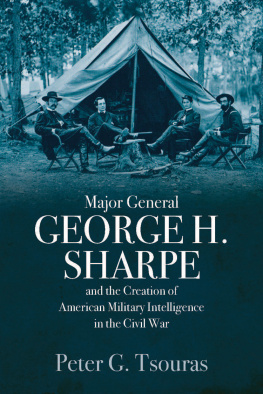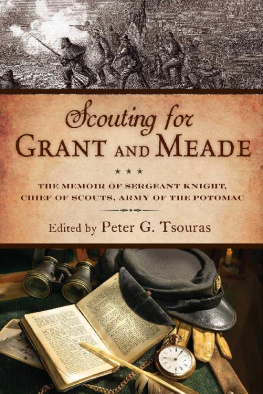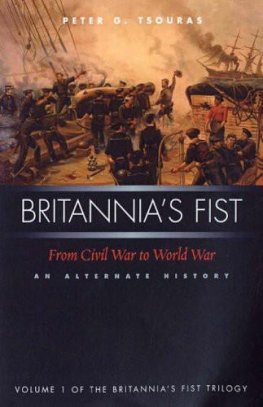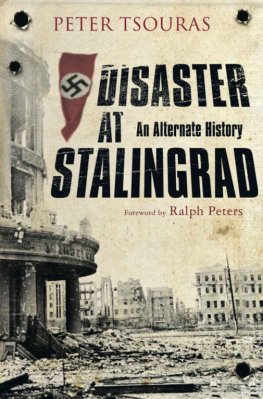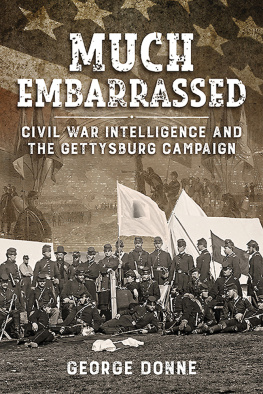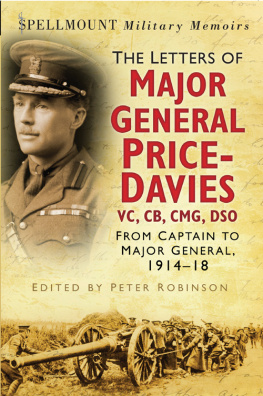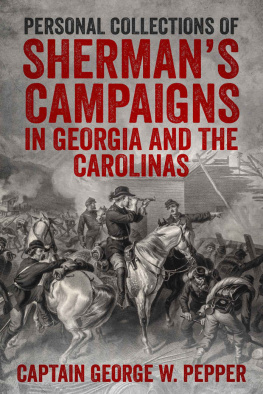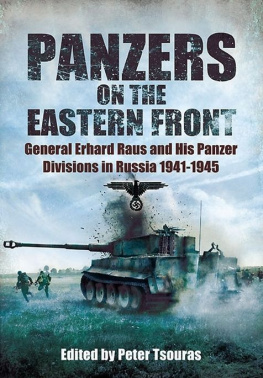Peter G. Tsouras - Major General George H. Sharpe and the Creation of American Military Intelligence in the Civil War
Here you can read online Peter G. Tsouras - Major General George H. Sharpe and the Creation of American Military Intelligence in the Civil War full text of the book (entire story) in english for free. Download pdf and epub, get meaning, cover and reviews about this ebook. year: 2018, publisher: Casemate, genre: History. Description of the work, (preface) as well as reviews are available. Best literature library LitArk.com created for fans of good reading and offers a wide selection of genres:
Romance novel
Science fiction
Adventure
Detective
Science
History
Home and family
Prose
Art
Politics
Computer
Non-fiction
Religion
Business
Children
Humor
Choose a favorite category and find really read worthwhile books. Enjoy immersion in the world of imagination, feel the emotions of the characters or learn something new for yourself, make an fascinating discovery.
- Book:Major General George H. Sharpe and the Creation of American Military Intelligence in the Civil War
- Author:
- Publisher:Casemate
- Genre:
- Year:2018
- Rating:5 / 5
- Favourites:Add to favourites
- Your mark:
- 100
- 1
- 2
- 3
- 4
- 5
Major General George H. Sharpe and the Creation of American Military Intelligence in the Civil War: summary, description and annotation
We offer to read an annotation, description, summary or preface (depends on what the author of the book "Major General George H. Sharpe and the Creation of American Military Intelligence in the Civil War" wrote himself). If you haven't found the necessary information about the book — write in the comments, we will try to find it.
Major General George H. Sharpe and the Creation of American Military Intelligence in the Civil War — read online for free the complete book (whole text) full work
Below is the text of the book, divided by pages. System saving the place of the last page read, allows you to conveniently read the book "Major General George H. Sharpe and the Creation of American Military Intelligence in the Civil War" online for free, without having to search again every time where you left off. Put a bookmark, and you can go to the page where you finished reading at any time.
Font size:
Interval:
Bookmark:

Peter G. Tsouras

Published in the United States of America and Great Britain in 2018 by
CASEMATE PUBLISHERS
1950 Lawrence Road, Havertown, PA 19083, USA
and
The Old Music Hall, 106108 Cowley Road, Oxford OX4 1JE, UK
Copyright 2018 Peter G. Tsouras
Hardcover Edition: ISBN 978-1-61200-647-5
Digital Edition: ISBN 978-1-61200-648-2 (epub)
Kindle Edition: ISBN 978-1-61200-648-2 (mobi)
A CIP record for this book is available from the British Library
All rights reserved. No part of this book may be reproduced or transmitted in any form or by any means, electronic or mechanical including photocopying, recording or by any information storage and retrieval system, without permission from the publisher in writing.
For a complete list of Casemate titles, please contact:
CASEMATE PUBLISHERS (US)
Telephone (610) 853-9131
Fax (610) 853-9146
Email:
www.casematepublishers.com
CASEMATE PUBLISHERS (UK)
Telephone (01865) 241249
Email:
www.casematepublishers.co.uk
This book is gratefully dedicated to Col. Stuart A. Herrington, US Army (ret), a master of the art of military intelligence, a paragon of charismatic and moral leadership, and my friend. If any man resembles Sharpe, it is Stu Herrington.
In war, wrote Union general Phillip H. Sheridan, information on the enemy figured so prominently in victorious battles and campaigns that it was truly the great essential of success. During the early days of the Civil War, however, Sheridans observation was not self-evident to predominantly civilian-turned-volunteer officers in the Union army whose knowledge of war extended little beyond what they gleaned from reading Sir Edward Creasys Fifteen Decisive Battles of the World (1851) or from a quick spin through a borrowed tactical manual. In fact, teaching military neophytes how to go from the march into battle line or how to fire by file took precedence over pursuing that great essential. Many soon discovered through experience, however, that tactical proficiency alone could not win battles and campaigns and that efficient intelligence-gathering and skilled analysis could be the difference between victory or defeat. But achieving this proved a tall order unless, of course, one could find a talented officer with the necessary skills and judgment to tackle the challenges of information collection and assessment under fire. For Union generals Joseph Hooker, George G. Meade, and U. S. Grant, however, a 34-year-old balding lawyer from New York was that man.
George Henry Sharpe came from the Hudson Valley in New York and, like many in the North, answered his nations call after Confederate forces fired on Fort Sumter on April 12, 1861. He quickly raised a regiment, the 120th New York Volunteer Infantry, and commanded it during the early days of the war. In 1862, Gen. Joseph Hooker, then head of the Army of the Potomac in Virginia, needed an officer with a keen and discerning mind to create and head his intelligence apparatus later known as the Bureau of Military Information (BMI). He chose Colonel (later General) Sharpe, who remained the BMI chief under Hooker, Meade, and Grant during many of the most important battles and campaigns of the conflict. But in this role Sharpe did far more than merely collect random bits of information and forward them to his bosses. He realized that information was only as reliable as its source and useful only if a commander could quickly make sense of it and use it. With this in mind, Sharpe created a tightly-knit unit staffed with smart and skilled intelligence professionals who collected raw information and then, through careful assessment and analysis, produced camera-ready military intelligence for use in the field.
Under Sharpes leadership, the BMI set the standard for efficient and effective intelligence work in the Civil War, becoming an all source intelligence unit that systematically gathered raw information from a multitude of sources (spies, scouts, cavalry reconnaissance, balloon ascensions, captured enemy correspondence, signal intercepts, enemy newspapers, and the results of interrogations of local civilians and prisoners of war), subjected it to rigorous corroboration and analysis, and then packaged it in a concise intelligence brief for the Army of the Potomac commander. Of all these sources, however, one of the most valuable was information derived from the interrogation of Confederate prisoners and deserters. Though far less exciting than the daring exploits of spies, the BMI extracted valuable information on the organizationor order of battleof Robert E. Lees Army of Northern Virginia. Determining the identity of a prisoners regiment, brigade, and corpssomething a captured soldier would certainly know and easily divulgeallowed Sharpes principal subordinate and former architect, John C. Babcock, to create an organizational flow chart of Lees army that was then used to track its dispositions and movements. The BMI became so proficient at collecting order of battle intelligence that Sharpe once bragged that he had identified each regiment, brigade, and division in Lees army and, as a result, knew their exact positions and any movements they made. In the midst of the campaign against Richmond in 1864, U. S. Grant confirmed Sharpes boast. Deserters come in every day, he told the War Department, enabling us to keep track of every change the enemy makes.
During the siege of Richmond and Petersburg from June 1864 to April 1865, the BMI reached peak efficiency. The unit employed numerous spies behind Confederate lines, posted scouts along Lees logistical connections, established covert lines of communication with Union spy Elizabeth Van Lew and her so-called Union Underground in the Confederate capital, and placed BMI branch offices with other commands in Virginia and North Carolina to transmit strategic intelligence to Grants City Point headquarters. In addition, after Lees surrender at Appomattox, Sharpe was charged with issuing paroles to the men of the Army of Northern Virginia, which proved challenging because Lees army had become quite disorganized during the final months of the siege as ever-shrinking numbers led to numerous unit consolidations and reorganizations that, in turn, muddied their order of battle. As a result, many Confederates lining up for their paroles were confused about the new identities of their regiments and brigades and where they fit in the organizational chart. But the BMI had done its job well. Much to the surprise of puzzled Confederates, Sharpe was able to tell them where they belonged using Babcocks up-to-date order of battle for the Army of Northern Virginia.
In the final analysis, Sharpes BMI was the most sophisticated and efficient intelligence organization during the war but also the first systematic all source intelligence organization in U.S. military history to that time. And it all emanated from the lawyerly mind of George H. Sharpe who, despite his incredibly important contributions to Union victory, remains virtually unknown in Civil War history.
After the war, which included Sharpes unsuccessful trip to Europe in search of evidence of the Confederate governments complicity in the assassination of President Abraham Lincoln, the BMI and its chief faded from view even as reminiscences written by other officers and common soldiers poured from the presses detailing their experiences during the late unpleasantness. Former scouts and spies like Allan Pinkerton, Lafayette Baker, Belle Boyd, and others also jumped in to this literary war, writing memoirs laced with embellished tall tales that would have made a dime novelist blush. Written more for profit and fame than to render an accurate depiction of intelligence work during the war, these offerings unfortunately obscured more than they revealed. Sharpe and his principal subordinates, however, contributed little to this literary outpouring, which meant that the thrilling adventures stories that so transfixed the publicmany with only a nodding acquaintance with the truthsoon became authoritative representations of the intelligence war.
Font size:
Interval:
Bookmark:
Similar books «Major General George H. Sharpe and the Creation of American Military Intelligence in the Civil War»
Look at similar books to Major General George H. Sharpe and the Creation of American Military Intelligence in the Civil War. We have selected literature similar in name and meaning in the hope of providing readers with more options to find new, interesting, not yet read works.
Discussion, reviews of the book Major General George H. Sharpe and the Creation of American Military Intelligence in the Civil War and just readers' own opinions. Leave your comments, write what you think about the work, its meaning or the main characters. Specify what exactly you liked and what you didn't like, and why you think so.

